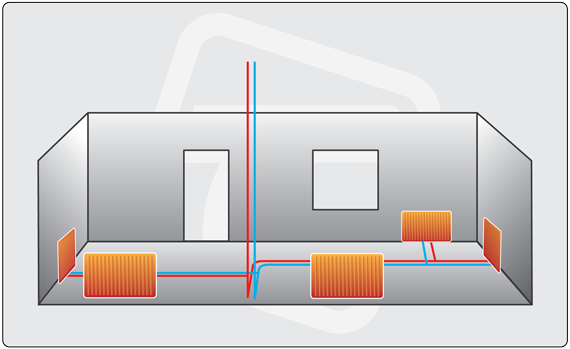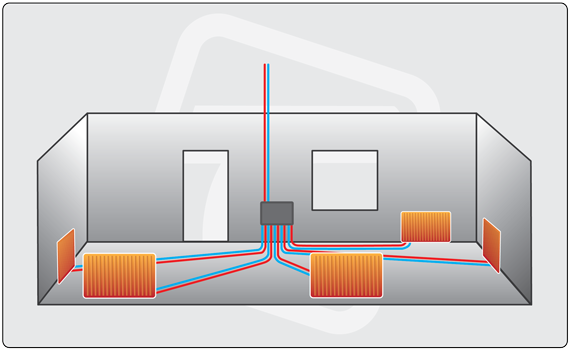
Tweetop PERT is one of the key components of Tweetop Home system. Based on pipes and press fittings and offered in diameters ranging from 14 to 75mm, it applies to broad spectrum of heating systems (max. 95 deg. C).
Tweetop PERT pipes and fittings are perfectly suited for heating installations in every type of buildings
Versatility of Tweetop PERT solution allows for every possible way of water distribution.
Heaters are supplied from the main line by branches leading to tees mounted on them. Supply lines are usually located in the floor or on the wall in following arrangements:
Circuit type - heating medium is distributed along the walls where heaters are mounted. This allows the use of masking bars, making this type of system ideal for renovation. Relatively large demand for pipe and the need to go through the construction barriers are the main disadvantages of this arrangement.
Radial type – heating medium is freely distributed from vertical supply line to the heaters without the need of getting through the construction barriers. The pipes are routed from the middle of the room which leads to reduction in their required length.

Tee based arrangements do not give any possibility to replace damaged pipes without forging floors or plaster. Moreover, connecting of additional heaters to the main supply line will gradually decrease the pressure and will cause trouble with flow adjustment on individual plots.
It is the major disadvantage of tee based arrangements in comparison to manifolds.
The ability to supply each radiator with a separate line that runs straight from the manifold is a specific feature of this arrangement.

Summary of qualities:
Within the Tweetop Home system, there are several brass manifolds available - designed for managing from 2 to 12 supply lines, depending on the actual type chosen.
Manifolds should be mounted in special cases, which can be mounted both directly on the plaster as well as countersunk below it. There is enough room in the case to incorporate cutting valves for every single circuit managed by given type of manifold.
On the installation design stage, it is important to remember about:
Tweetop PERT system contains a full spectrum of connections for every type of radiators
Connection based on press screw couplings or press coupling - reducers, with utilization of Tweetop PERT pipes advantages allowing for pipe bending radius being equal to 4 times its inner diameter.

Connection based on press screw couplings with utilization of Tweetop PERT pipes advantages allowing for pipe bending radius being equal to 4 times its inner diameter.

Connection based on knee with 15mm diameter nickel plated copper pipe.

Connection based on tee with 15mm diameter nickel plated copper pipe.
